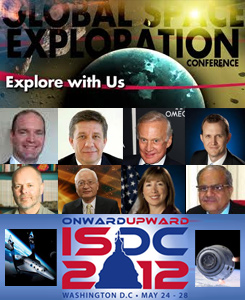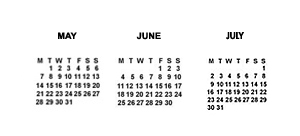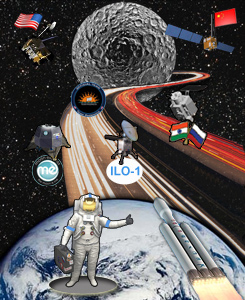Independent Human Moon Mission: Prospects Emerging From Rising Tide of 21st Century Exploration
The Moon’s South Pole invites first visits / development of a whole new world and humanity’s renewal as multi-world species. A cooperative initiative coalescing between independent, national and international enterprises could see 2-4 people on the surface for 1-4 weeks at an estimated cost of US$5-10 billion. The immediate objectives would be to lay foundations for a permanent outpost and service preexisting robotic laboratories. There is currently a swell of robotic Moon missions that have or may(*) declare for Moon South Pole landing, including: GLXP Team Phoenicia, Astrobotic and others in 2014-15; India/Russia Chandrayaan-2* NET 2014; ILO-1 in 2015, China Chang’e-4* in 2015-2016, and China Chang’e-5, 6* in 2016-2018; as well as concepts from NASA, Japan, Europe and Russia from 2013 and beyond. Emerging from the growing tide of exploration are various plans for Human Moon missions. The International Lunar Observatory Association has a goal to fund 10% of the estimated cost of a Human Moon South Pole surface mission by the end of the decade. A privately circulated proposal, known as “Golden Spike” and backed by respected scientific and astronautical entities, envisions the development of a reliable “Cislunar Superhighway”. NASA is developing plans based on the Orion capsule to conduct a Human flight to lunar orbit by 2021. Space Adventures, a space tourism outfit, is advertising a 2017 circum-lunar flight priced at US$150 million. Perhaps the Sputnik effect of a successful China Chang’e-3 Moon-lander in 2013 will catalyze significant acceleration of independent Human Moon mission efforts. (Image Credit: ILOA, Team Phoenica, Moon Express, SpaceX, ISRO, CNSA, NASA, William Neff – The Plain Dealer)
International Space Conferences in Washington DC Focus on Exploration, Development
 Space industry leaders, scientists and entrepreneurs will gather in Washington DC for 2 international conferences aimed to advance future space initiatives in the global community. On May 22-24, the AIAA and the International Astronautical Federation will hold ‘Global Space Exploration Conference 2012.’ The event will open with a ‘Heads of Space Agencies Global Space Exploration’ panel moderated by AIAA Executive Director Bob Dickman, featuring NASA Administrator Charles Bolden, ESA Director Jean-Jacques Dordain, Canadian Space Agency President Steve MacLean, Russian Federal Space Agency Head Vladimir Alexandrovich Popovkin (T2), JAXA President Tachikawa Keiji (B2) and ISRO Scientist Ranganath Navalgund (B4). University of Notre Dame Professor Clive Neal (B1) will give a keynote lecture on ‘Exploring the Moon and Asteroids: A Synergistic Approach.’ The event will include 16 sessions on various topics such as returning to the Moon, robotic precursors to human exploration, and lunar and asteroid mining. On May 24-28, the National Space Society will hold the ‘31st International Space Development Conference.’ Participants will discuss transportation to and through space and the technology needed to live and work in space. Featured speakers include Virgin Galactic CEO George Whitesides (T4), Apollo 11 Astronaut Buzz Aldrin (T3) and NASA Deputy Administrator Lori Garver (B3). Sierra Nevada Space Systems Chairman Mark Sirangelo (T1) will be the May 25 keynote speaker and will also present the Space Pioneer Awards to John Glenn and Scott Carpenter. Pictured: MDA Vice President Space Division Christian Sallaberger (T1). (Image Credit: AIAA, IAF, NSS, NASA, nias.res.in, SpaceX, Virgin Galactic, GLEX2012.org, zimbio.com, googlelunarxprize.com)
Space industry leaders, scientists and entrepreneurs will gather in Washington DC for 2 international conferences aimed to advance future space initiatives in the global community. On May 22-24, the AIAA and the International Astronautical Federation will hold ‘Global Space Exploration Conference 2012.’ The event will open with a ‘Heads of Space Agencies Global Space Exploration’ panel moderated by AIAA Executive Director Bob Dickman, featuring NASA Administrator Charles Bolden, ESA Director Jean-Jacques Dordain, Canadian Space Agency President Steve MacLean, Russian Federal Space Agency Head Vladimir Alexandrovich Popovkin (T2), JAXA President Tachikawa Keiji (B2) and ISRO Scientist Ranganath Navalgund (B4). University of Notre Dame Professor Clive Neal (B1) will give a keynote lecture on ‘Exploring the Moon and Asteroids: A Synergistic Approach.’ The event will include 16 sessions on various topics such as returning to the Moon, robotic precursors to human exploration, and lunar and asteroid mining. On May 24-28, the National Space Society will hold the ‘31st International Space Development Conference.’ Participants will discuss transportation to and through space and the technology needed to live and work in space. Featured speakers include Virgin Galactic CEO George Whitesides (T4), Apollo 11 Astronaut Buzz Aldrin (T3) and NASA Deputy Administrator Lori Garver (B3). Sierra Nevada Space Systems Chairman Mark Sirangelo (T1) will be the May 25 keynote speaker and will also present the Space Pioneer Awards to John Glenn and Scott Carpenter. Pictured: MDA Vice President Space Division Christian Sallaberger (T1). (Image Credit: AIAA, IAF, NSS, NASA, nias.res.in, SpaceX, Virgin Galactic, GLEX2012.org, zimbio.com, googlelunarxprize.com)

![]() = All times for terrestrial events in local time unless noted.
= All times for terrestrial events in local time unless noted.
![]() = All times for international terrestrial events in local time unless noted.
= All times for international terrestrial events in local time unless noted.
![]() = All times for space events, and…
= All times for space events, and…
![]() = All times for international space / astro events in Hawaii Standard Time unless noted. Add 10 hours to obtain UT (‘Universal Time;’ Greenwich, England).
= All times for international space / astro events in Hawaii Standard Time unless noted. Add 10 hours to obtain UT (‘Universal Time;’ Greenwich, England).
Weekly Planet Watch – Evening Planets: Venus (WNW), Mars (SSW), Saturn (S).
MONDAY
![]() May 21 — International Space Station, LEO: E-31 crew members continue operating at full strength aboard the ISS; If May 19 launch of SpaceX Dragon C2 successful, crew members will use Canadarm2 to grapple Dragon on May 22 for a berthing to the Harmony node.
May 21 — International Space Station, LEO: E-31 crew members continue operating at full strength aboard the ISS; If May 19 launch of SpaceX Dragon C2 successful, crew members will use Canadarm2 to grapple Dragon on May 22 for a berthing to the Harmony node.
![]() May 21 — Lunar Reconnaissance Orbiter (LRO), Lunar Orbit: NASA LRO functioning nominally in its 50±15 km near-circular orbit as it makes digital elevation and surface maps that will be fundamental references for future human exploration.
May 21 — Lunar Reconnaissance Orbiter (LRO), Lunar Orbit: NASA LRO functioning nominally in its 50±15 km near-circular orbit as it makes digital elevation and surface maps that will be fundamental references for future human exploration.
![]() May 21 — Mars Opportunity Rover, Red Planet: All systems nominal with NASA rover as it resumes operations at the north end of Cape York; Total odometry to date: 34,365.04 meters.
May 21 — Mars Opportunity Rover, Red Planet: All systems nominal with NASA rover as it resumes operations at the north end of Cape York; Total odometry to date: 34,365.04 meters.
![]() May 21 — Jupiter Juno Mission, Jupiter Trajectory: Juno spacecraft is in excellent health and is operating nominally; Four instruments are turned on: the Magnetometer experiment (FGM & ASC), JEDI, MWR and Waves.
May 21 — Jupiter Juno Mission, Jupiter Trajectory: Juno spacecraft is in excellent health and is operating nominally; Four instruments are turned on: the Magnetometer experiment (FGM & ASC), JEDI, MWR and Waves.
![]() May 21 — Commonwealth Scientific and Industrial Research Organization, Sydney, Australia: ‘Colloquium: The Distribution of Star-Forming Regions in the Milky Way.’
May 21 — Commonwealth Scientific and Industrial Research Organization, Sydney, Australia: ‘Colloquium: The Distribution of Star-Forming Regions in the Milky Way.’
![]() May 21-22 — Wien University – Dept. of Astronomy, Vienna, Austria: ‘Workshop on Extraterrestrial Life: Beyond Our Expectations?‘
May 21-22 — Wien University – Dept. of Astronomy, Vienna, Austria: ‘Workshop on Extraterrestrial Life: Beyond Our Expectations?‘
![]() May 21-23 — The National Science Foundation, Boulder CO: ‘Coronal Magnetism Workshop 2012: Connecting Models to Data and the Corona to the Earth.’
May 21-23 — The National Science Foundation, Boulder CO: ‘Coronal Magnetism Workshop 2012: Connecting Models to Data and the Corona to the Earth.’
![]() May 21-23 — ESA, Madrid, Spain; Noordwijk, The Netherlands; Santorini, Greece: ‘XMM- Newton 2012 Science Workshop: Galaxy Clusters as Giant Cosmic Laboratories;’ ‘Microwave Technology and Techniques Workshop 2012: Challenges of the Future;’ ‘International Forum on Satellite Earth Observation for Geo-Hazard Risk Management.’
May 21-23 — ESA, Madrid, Spain; Noordwijk, The Netherlands; Santorini, Greece: ‘XMM- Newton 2012 Science Workshop: Galaxy Clusters as Giant Cosmic Laboratories;’ ‘Microwave Technology and Techniques Workshop 2012: Challenges of the Future;’ ‘International Forum on Satellite Earth Observation for Geo-Hazard Risk Management.’
![]() May 21-24 — Applied Technology Institute, Huntsville AL: ‘Space Systems Fundamental Course,’ Mike Gruntman.
May 21-24 — Applied Technology Institute, Huntsville AL: ‘Space Systems Fundamental Course,’ Mike Gruntman.
![]() May 21-24 — Terrapin Holdings Ltd, Johannesburg, South Africa: ‘SatCom 2012: Innovation and Investments for Operators and End-Users.’
May 21-24 — Terrapin Holdings Ltd, Johannesburg, South Africa: ‘SatCom 2012: Innovation and Investments for Operators and End-Users.’
![]() May 21-25 — Lunar and Planetary Institute, NASA Mars Program Office, et al, Carson City NV: ‘3rd International Conference on Early Mars: Geologic and Hydrologic Evolution, Physical and Chemical Environments, and Implications for Life.’
May 21-25 — Lunar and Planetary Institute, NASA Mars Program Office, et al, Carson City NV: ‘3rd International Conference on Early Mars: Geologic and Hydrologic Evolution, Physical and Chemical Environments, and Implications for Life.’
![]() May 21-25 — Kyoto University, University of Tsukuba, et al, Kyoto, Japan: ‘4th First Stars Conference: From Hayashi to the Future.’
May 21-25 — Kyoto University, University of Tsukuba, et al, Kyoto, Japan: ‘4th First Stars Conference: From Hayashi to the Future.’
![]() May 21-26 — Kennedy Space Center, Cape Canaveral FL: ‘NASA 3rd Annual Lunabotics Mining Competition.’
May 21-26 — Kennedy Space Center, Cape Canaveral FL: ‘NASA 3rd Annual Lunabotics Mining Competition.’
![]() May 21 — Moon: 5.0° N of Aldebaran; 11:00.
May 21 — Moon: 5.0° N of Aldebaran; 11:00.
![]() May 21 — Mercury: 0.41° NW of Jupiter; 18:00.
May 21 — Mercury: 0.41° NW of Jupiter; 18:00.
![]() May 21 — Asteroid 29075 (1950 DA): Closest Approach to Earth (0.238 AU).
May 21 — Asteroid 29075 (1950 DA): Closest Approach to Earth (0.238 AU).
Continued from…
![]() May 18 — Kennedy Space Center, Cape Canaveral FL: Media pre-launch / post launch coverage of the SpaceX Falcon 9 rocket carrying a Dragon capsule for NASA’s Commercial Orbital Transportation Services (COTS); through May 23.
May 18 — Kennedy Space Center, Cape Canaveral FL: Media pre-launch / post launch coverage of the SpaceX Falcon 9 rocket carrying a Dragon capsule for NASA’s Commercial Orbital Transportation Services (COTS); through May 23.
![]() May 19 — International Academy of Astronautics, Porto, Portugal: ‘1st IAA Conference on Dynamics & Control of Space Systems;’ through May 21.
May 19 — International Academy of Astronautics, Porto, Portugal: ‘1st IAA Conference on Dynamics & Control of Space Systems;’ through May 21.
![]() May 20 — Japan Geoscience Union (JGU), Chiba City, Japan: ‘JpGU Meeting 2012;’ through May 25.
May 20 — Japan Geoscience Union (JGU), Chiba City, Japan: ‘JpGU Meeting 2012;’ through May 25.
![]() May 20 — Aspen Center for Physics, Aspen CO: Aspen Summer Meeting 2012: ‘A Window to the Formation of the Milky Way;’ through June 9.
May 20 — Aspen Center for Physics, Aspen CO: Aspen Summer Meeting 2012: ‘A Window to the Formation of the Milky Way;’ through June 9.
TUESDAY
![]() May 22-24 — American Institute of Aeronautics and Astronautics, International Astronautical Federation, Washington DC: ‘Global Space Exploration Conference 2012.’
May 22-24 — American Institute of Aeronautics and Astronautics, International Astronautical Federation, Washington DC: ‘Global Space Exploration Conference 2012.’
![]() May 22-25 — Canadian Space Agency, Montreal, Quebec, Canada: ‘The 30th Inter-Agency Space Debris Coordination Committee Meeting.’
May 22-25 — Canadian Space Agency, Montreal, Quebec, Canada: ‘The 30th Inter-Agency Space Debris Coordination Committee Meeting.’
![]() May 22 — Moon: 4.7° S of Venus; 12:00.
May 22 — Moon: 4.7° S of Venus; 12:00.
WEDNESDAY
![]() May 23 — Space Transportation Association, Washington DC: ‘STA Luncheon,’ with Langley Research Director Lesa Roe.
May 23 — Space Transportation Association, Washington DC: ‘STA Luncheon,’ with Langley Research Director Lesa Roe.
THURSDAY
![]() May 24-28 — National Space Society, Washington DC: ‘31st International Space Development Conference 2012.’
May 24-28 — National Space Society, Washington DC: ‘31st International Space Development Conference 2012.’
![]() May 24 — Cassini OTM-323, Saturn Orbit: Spacecraft conducts Orbital Trim Maneuver #323 today.
May 24 — Cassini OTM-323, Saturn Orbit: Spacecraft conducts Orbital Trim Maneuver #323 today.
![]() May 24 — Moon: 10.6° SSW of Pollux; 22:00.
May 24 — Moon: 10.6° SSW of Pollux; 22:00.
![]() May 24 — Mercury: 4.0° SSE of the Pleiades; 07:00.
May 24 — Mercury: 4.0° SSE of the Pleiades; 07:00.
FRIDAY
![]() May 25 — Space Center Houston, Houston TX: ‘Lunch With an Astronaut,’ Mike McCulley.
May 25 — Space Center Houston, Houston TX: ‘Lunch With an Astronaut,’ Mike McCulley.
![]() May 25 — The Republic of Turkey, The European Union, Istanbul, Turkey: ‘TurKey Enabling Technologies 2012.’
May 25 — The Republic of Turkey, The European Union, Istanbul, Turkey: ‘TurKey Enabling Technologies 2012.’
![]() May 25, 26 — Smithsonian National Air and Space Museum, Washington DC: ‘Flights of Fancy: Stories for Children – Planets,’ Ellen Hasbrouck.
May 25, 26 — Smithsonian National Air and Space Museum, Washington DC: ‘Flights of Fancy: Stories for Children – Planets,’ Ellen Hasbrouck.
SATURDAY
![]() May 26 — Moon: 6.0° SSW of Beehive Cluster; 02:00.
May 26 — Moon: 6.0° SSW of Beehive Cluster; 02:00.
![]() May 26 — Asteroid 7986 Romania: Closest Approach to Earth (0.862 AU).
May 26 — Asteroid 7986 Romania: Closest Approach to Earth (0.862 AU).
SUNDAY
![]() May 27 – Jun 3 — Weizmann Institute of Science, Rehovot, Israel: ‘Planetary Origins and Frontiers of Exploration.’
May 27 – Jun 3 — Weizmann Institute of Science, Rehovot, Israel: ‘Planetary Origins and Frontiers of Exploration.’
![]() May 27 — Moon: 5.8° SSW of Regulus; 19:00.
May 27 — Moon: 5.8° SSW of Regulus; 19:00.
![]() May 27 — Asteroid 8553 Bradsmith: Closest Approach to Earth (1.021 AU).
May 27 — Asteroid 8553 Bradsmith: Closest Approach to Earth (1.021 AU).
